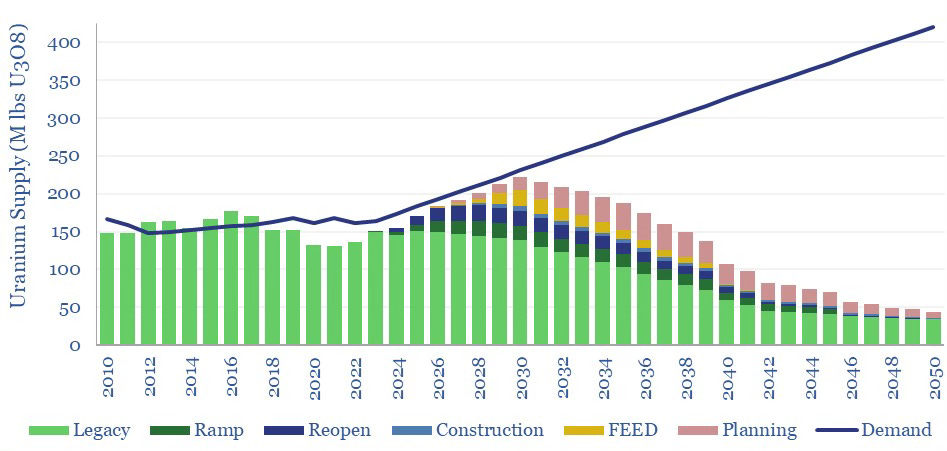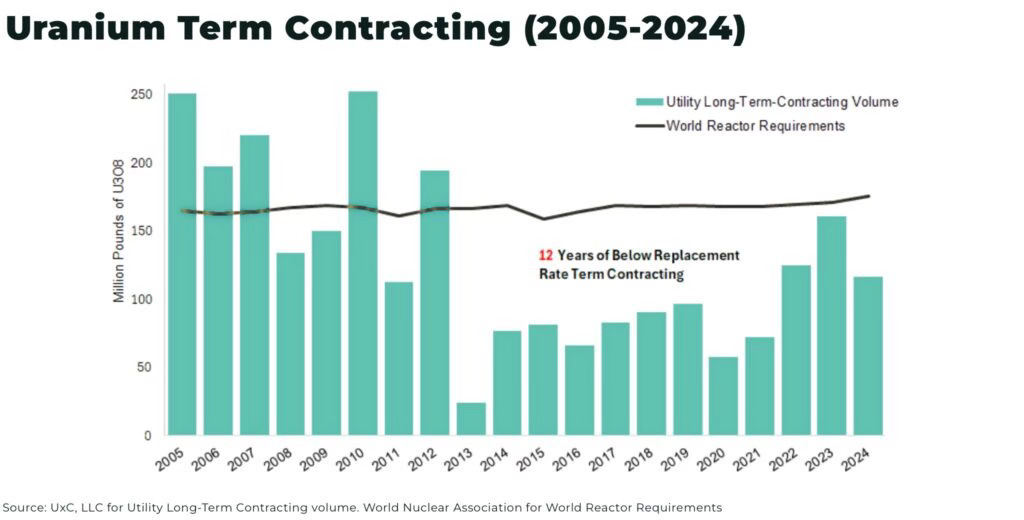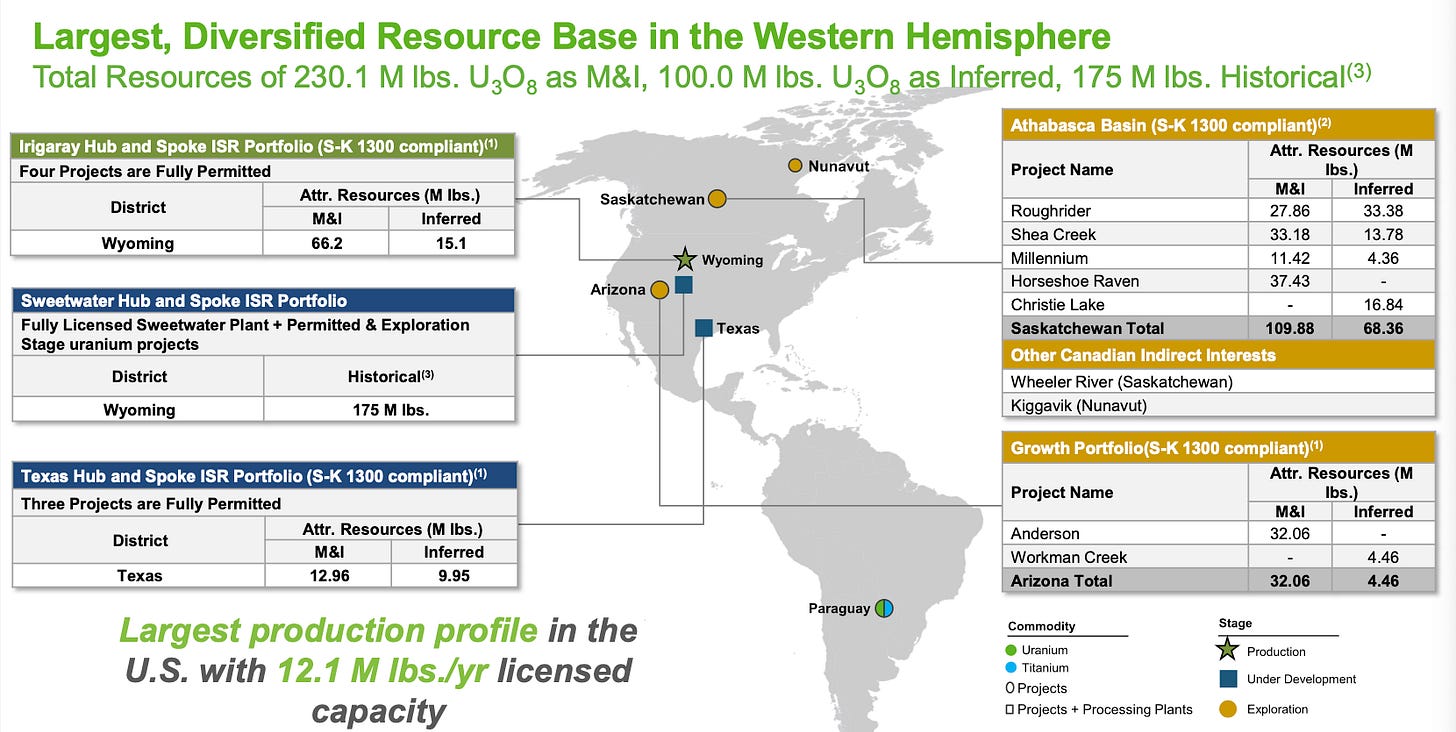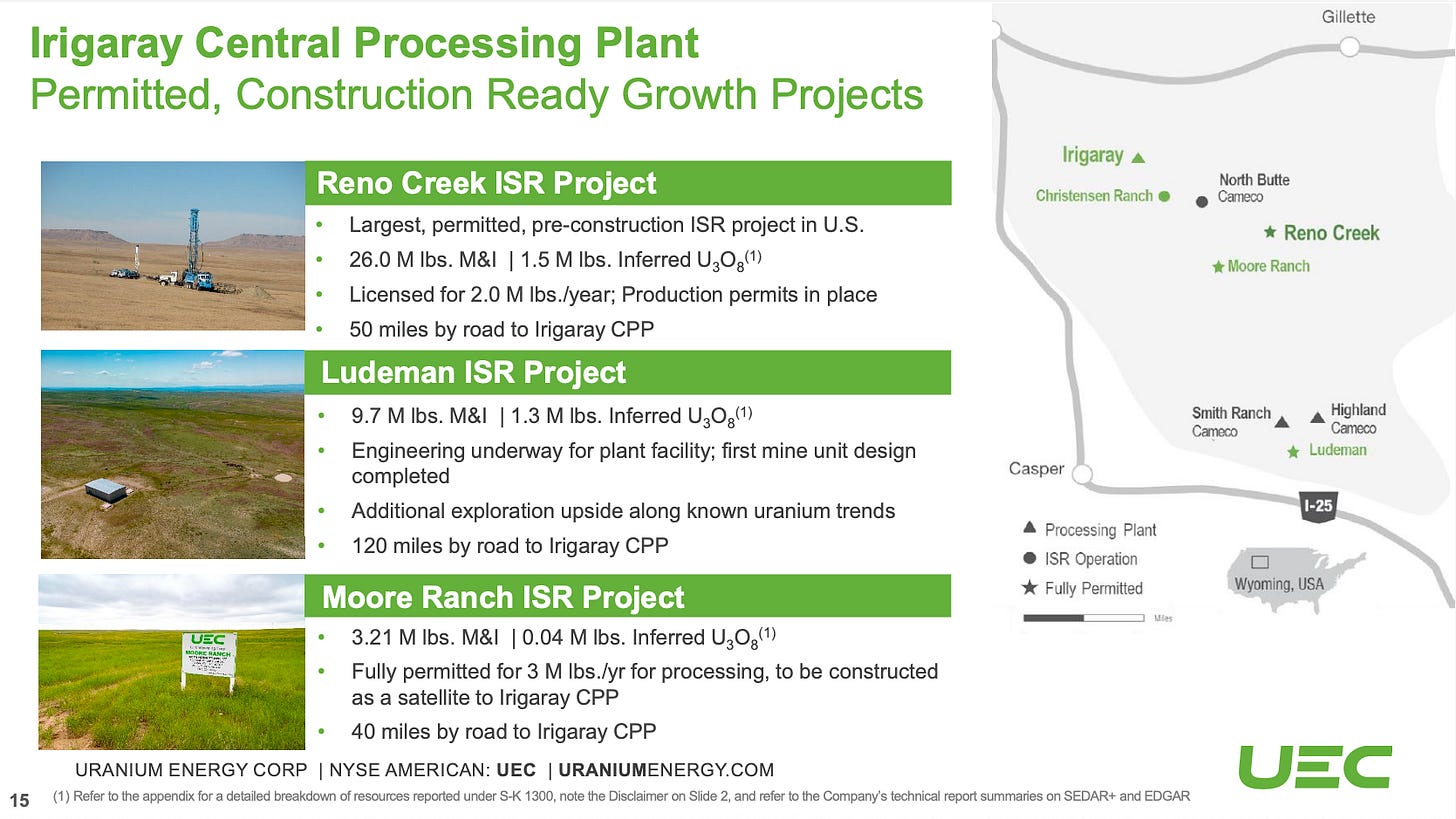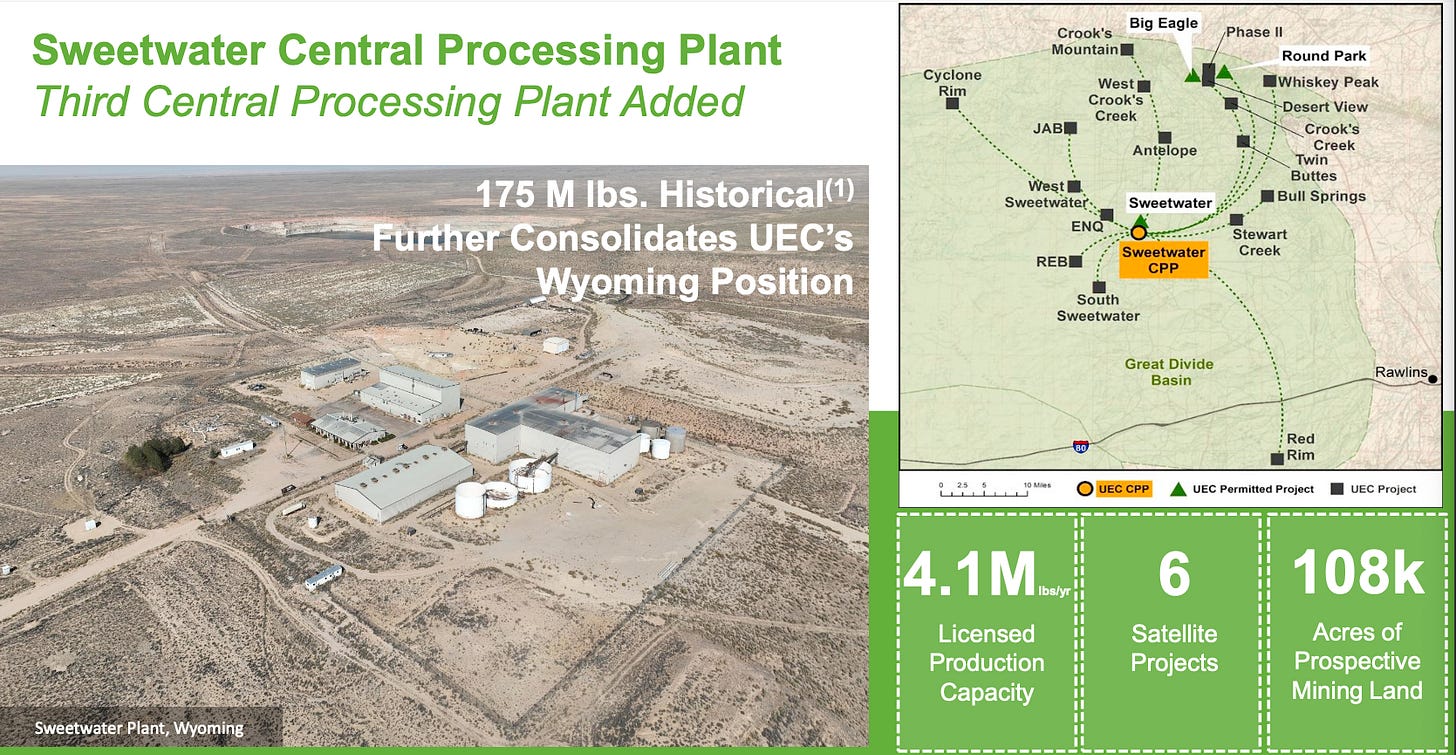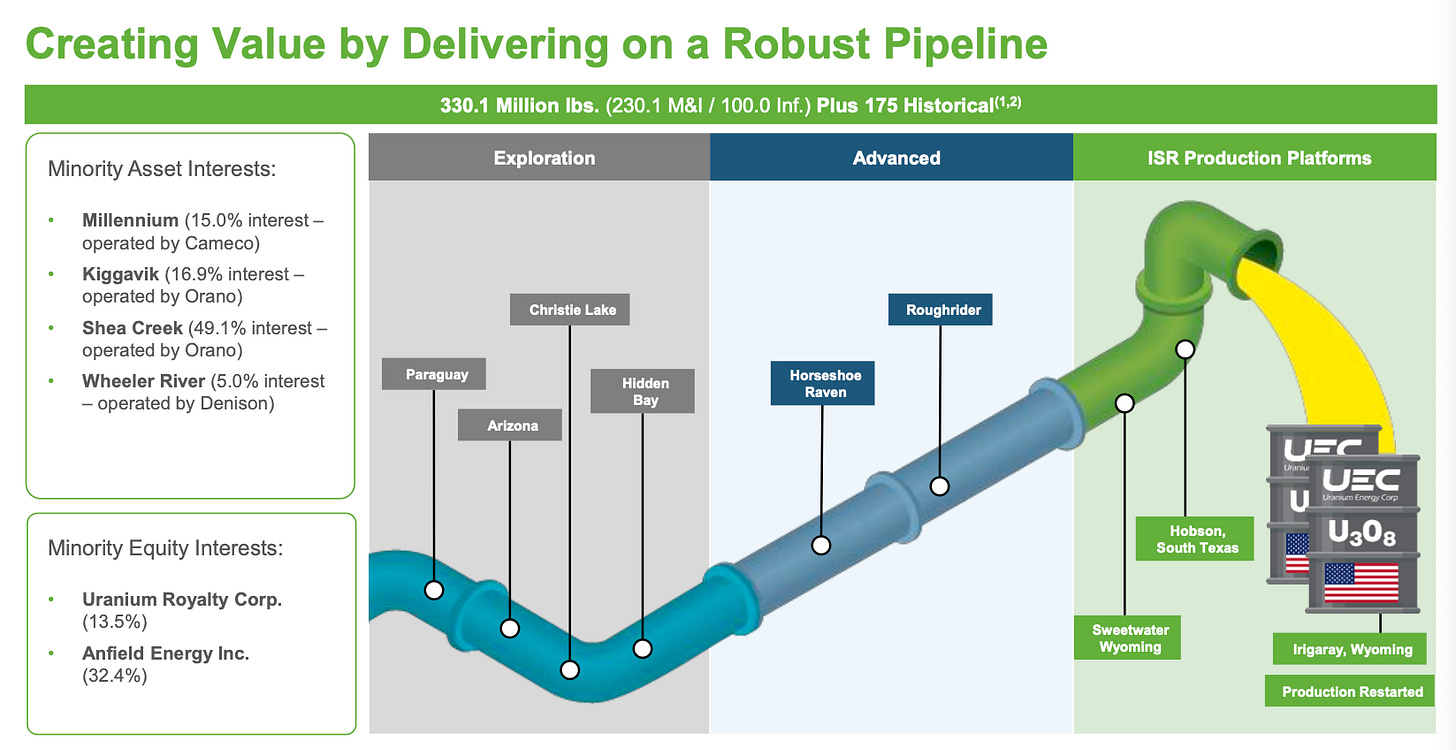Uranium Energy Corp (UEC) - Uranium Growth Story at a 54% Discount
Rapidly Growing Uranium Miner Set to Benefit From Decade-Long Tailwinds
Summary
Uranium Energy Corp (UEC) is a rapidly growing uranium miner well-positioned to benefit from the rapidly growing demand. At the same time, the supply is heavily constrained and struggles to keep up, resulting in a significant gap that is only expected to grow.
Currently in its early production phase, UEC is an attractive investment opportunity due to its extensive resource base, effective capital deployment strategy, strong financial health, and a favorable macroeconomic environment.
The company holds one of the largest uranium portfolios globally, with over 230 million pounds (mmlbs) of Measured & Indicated (M&I) resources, as well as 175mmlbs of historical resources and 100mmlbs of inferred resources. This substantial resource base supports a projected rapid increase in production—from approximately 0.2mmlbs in 2025E to 1.2mmlbs in 2026 and 2.8mmlbs in 2027. This represents a 14-fold increase in volume over two and a half years, with the potential to reach around 6 mmlbs of uranium oxide compound (U3O8 - yellowcake component, or for simplification - uranium) by 2030-2031, contributing to rapidly growing cash flow.
UEC primarily utilizes In-Situ Recovery (ISR) mining, which is an environmentally friendly and relatively low-cost method. The company operates two established ISR hubs in South Texas and Wyoming, with plans for a third site based on ex-Rio Tinto's Wyoming assets. Collectively, these platforms aim for a licensed production capacity of 12.1mmlbs of U3O8 per year, which could be achieved over the next decade.
The current uranium market is characterized by a severe and persistent supply-demand imbalance. In 2025, consumption is expected to reach around 185mmlbs, while production is forecasted at approximately 170mmlbs, leading to a significant gap that could widen to as much as 75mmlbs by 2050 based on current production projections. This situation, combined with record-low uranium inventories and an increasing global focus on nuclear power, is creating significant price pressure for uranium.
While recent fluctuations in spot prices have caused concern among speculators and dampened sentiment in the uranium market, this environment has created opportunities for finding value again. Long-term contract prices have remained high at around $80 per pound, and spot prices have made a comeback. The main cause seems to be the nuclear power plants delaying refueling to search for more opportune prices and diversify from Kazakhstan and Russia (not always successfully).
Financially, UEC is in a strong position with zero debt and a healthy net cash position of approximately $139mm. The company also maintains a significant physical uranium inventory of 1.35mmlbs, valued at around $108 million at current market prices. This, along with a conservative spending approach (an estimated capital expenditure of $50-60mm over the next few years), significantly mitigates the risk of shareholder dilution socommon for aggressively growing businesses.
By focusing on acquiring high-quality, early-stage assets and utilizing its low-cost ISR method, UEC aims to become the second-largest uranium provider in North America, following Cameco.
UEC's emphasis on production in the U.S. and Canada aligns with Western energy independence goals, potentially allowing the company to benefit from future government subsidies and continuous tariffs on uranium imports from Russia.
Our Net Asset Value (NAV) valuation, based on a projected uranium price of $100/lb in three years and an 8% WACC, indicates a NAV of approximately $13.65 per share, suggesting an 118% upside potential over the next three years (26% IRR). Even at the current uranium price of about $80 per pound, the company appears undervalued, with an estimated fair value of around $10.83 per share, representing a roughly 73% upside.
The significant margin of safety is provided by an extremely valuable uranium portfolio, strong balance sheet, and strategic positioning in a supply-constrained market.
Key catalysts for UEC include: 1) the rapid increase in production from its Wyoming and Texas operations in the coming year, and 2) the long-awaited resupply purchases from nuclear power producers.
Download Our Model
Before we begin, I would like to thank
for introducing us to UEC 0.00%↑ and inviting us to work together on this piece. He’s a great author regularly posting about energy markets. Give him a follow! It’s worth it.Business Overview
Uranium Energy Corp (UEC) is primarily a uranium mining company focused on supplying uranium oxide compound (aka uranium fuel) for nuclear energy production. Founded in 2003, UEC has completed hundreds of exploratory drillings and is positioning itself as a key player in the North American uranium supply chain.
The company's core business centers around In-Situ Recovery (ISR) mining, a method designed to minimize surface disruption. UEC operates two ISR "hub-and-spoke" platforms located in South Texas and Wyoming, with plans for a third platform based on Rio Tinto's Wyoming assets. This expansion is expected to increase their combined U.S. licensed production capacity to 12.1mmlbs of U3O8 per year. In addition to their U.S. operations, UEC also holds diversified uranium assets in Canada and Paraguay.
UEC has estimated measured and indicated (M&I) resources of over 230mmlbs of U3O8, with historical and inferred estimates standing at 175mmlbs and 100mmlbs, respectively. These holdings represent one of the largest uranium portfolios in the world.
UEC maintains a substantial physical uranium portfolio of 1.35mmlbs, stored in the U.S., which is valued at approximately $108mm based on current uranium prices. The portfolio is unhedged, and given the favorable market conditions for uranium, it presents an attractive investment opportunity.
Additionally, UEC is in a robust financial position, with no debt and net cash reserves of $139mm, including cash from its at-the-market (ATM) offerings.
We anticipate that UEC will significantly ramp up production, increasing from roughly 0.2mmlbs in 2025E to 1.2mmlbs in 2026E, and then to 2.8mm lbs in 2026. By 2030-2031, the company could potentially reach around 6mm lbs of production based on our estimates crosschecked with other equity researchers including SCP Equity Research.
We think that in short UEC’s strategy includes utilizing its cost-efficient in-situ recovery (ISR) mining method and acquiring undervalued assets. As a result, it is highly likely that UEC will become the second-largest uranium supplier in North America, following Cameco, within the next decade.
Uranium Macro — Complete Comeback
Almost everyone recognizes how crucial energy has become in our modern world. Everything we use and interact with requires energy for operation or manufacturing. The rapidly growing demands of data centers and the trend towards decentralized and independent power supply reinforce this importance. After many years of stagnation, interest in nuclear power has started to rise again.
The nuclear industry faced a decade-long slump following the Fukushima incident in 2011. During this time, alternative energy providers lobbied for other clean but perceived safer options. However, the main challenges were reliability—specifically, the predictability of energy supply—and the significant power draw requirements that became evident during the COVID-19 pandemic and the European Energy Crisis.
With uranium supply declining since 2018, the sector began to attract more attention. A major turning point was the post-COVID recovery and the evident problems with renewable energy capacity in Europe, which were put to the test during the European Energy Crisis in 2022.
Since then, the nuclear industry has experienced a resurgence. Growing energy needs and logical reasoning have prevailed over irrational fears. Nuclear power is highly efficient, reliable, and clean. The primary drawbacks include substantial initial costs and lengthy construction times, which can reach up to 15 years. Some also argue that nuclear power contributes to grid centralization; however, recent breakthroughs in Small Modular Reactor technology could address this concern.
Ultimately, more than 30 countries are now planning to increase their nuclear capacities by 2 to 3 times by 2050, which is expected to significantly boost demand over the coming decades, but let’s dig deeper.
Extreme Demand-Supply Imbalance
There has been a significant imbalance between the demand and supply of uranium that has persisted since 2018. In 2025, uranium consumption is expected to be just below 185mmlbs, while demand is projected to reach nearly 270mmlbs by 2035.
On the supply side, production in 2025 is expected to be around 170mmlbs, resulting in a gap of approximately 15mmlbs. Looking ahead to 2035, with the projected production levels, supply is anticipated to increase only to about 195mmlbs. This would create a staggering gap of 75mmlbs. Such an imbalance is clearly unsustainable and must be addressed by ramping up the production, but even with increased investment It could not be enough and prices could face a persistent pressure for a very long time.
Inventories at Record Lows
In 2021, the supply-demand imbalance reached record levels, approaching 30mmlbs. At that time, substantial uranium inventories were available, which helped bridge the gap. However, those reserves are now gone. We have reached new lows for uranium inventories globally at just nearly 5mmlbs available this year.
So the situation differs significantly between now and the uranium mania from 2021, as the inventory that once covered this gap has almost completely diminished. This means that not only will the gap persist, but the low inventory levels will also make the market very vulnerable to any potential shortages. This is a very attractive macro setup.
Uranium Price Divergence is Fooling the Street
Since 2020, uranium prices have risen steadily, reaching around $100 per pound in the spot markets by early 2024. However, they have since declined to the mid-$60s but recently showed signs of recovery. This price drop has cooled the previously strong nuclear sentiment in the market.
Despite this fluctuation, long-term contract prices have stabilized at $80 per pound, where they remained.
Uranium Spot vs Long-term Price (US$/lb)
If the gap between supply and demand, although smaller, remains persistent and may widen, what is causing this divergence?
According to The Oregon Group, only 11 million pounds of uranium were transacted in the first quarter of 2025, significantly lower than the estimated demand of approximately 41mm bs if annual estimate were spread equally over the year. This shortfall follows a 17mmlbs deficit in 2024 when utilities purchased only two-thirds of the uranium needed to meet their future nuclear energy generation requirements.
It appears that many nuclear power plants are operating with low fuel supplies, and with fuel replacement needed every 18-24 months, they will not be able to sustain this for more than an additional 3-6 months. Given the recent uptick in spot prices, we believe they will return to a growth trend. The fundamentals of the market will once again resonate with investors.
Our Macro Thesis
In summary, we believe that, now is the time for the sustained appreciation of uranium prices. This is due to the ongoing supply-demand gap, which is not expected to close anytime soon, as well as rapidly depleting inventories and the necessity for nuclear power producers to restock their plants. Interestingly, this shift occurs just as public interest has largely turned towards data centers and other sectors leaving once hot uranium. There is potential for finding value in uranium again.
Uranium sector reminds us of offshore drilling, characterized by declining supply and growing demand, yet faced with persistent pessimism. Following the surge in optimism between 2020 and 2022, enthusiasm for the industry has significantly diminished.
Why We Chose UEC For Uranium Exposure?
Spot Market Sales (incredible uranium price torque): UEC primarily sells uranium on the spot market, unlike most uranium miners and processors. This strategy gives them incredible operating leverage, allowing for greater upside potential without being tied to fixed contract amounts. However, it also exposes them to downside risks during market retraces. Historically, producers of well-performing commodities often outperform the commodities themselves.
Strong Growth Portfolio: UEC is actively acquiring promising assets in the early stages of development, with ample resources to be mined. While they have a long way to go before becoming one of the largest producers, their portfolio is competitive in terms of resource estimates. This positions them well for future growth, especially with potential increases in uranium prices as they ramp up production.
Acquisition of Anfield Energy (AEC): UEC seems to be pursuing a takeover of Anfield Energy, in which they currently hold roughly one-third of the company. Capturing a controlling stake would enhance their dominance in the U.S. resource base, providing economies of scale and making UEC more likely to trade or be acquired at a premium. Potential investors could include:
- Oil & Gas Companies: Looking to diversify their portfolios away from oil, especially given the decline in shale production in the United States.
- Large Uranium Producers: They could leverage their scale and expertise to lower all-in sustaining costs (AISC) per pound of uranium produced, while also realizing synergies such as reduced headcount.
- Nuclear Utilities: With a need to secure long-term fuel supplies, they could benefit from vertical integration in a sustained uranium shortage.
US & Canada-based Producer (Key to energy independence of the West): Post-2020 and 2022, governments are increasingly focused on supply chains, particularly in strategic industries like energy. Producing uranium in the U.S. is essential for achieving desired energy independence, allowing the U.S. and other NATO countries to reduce their reliance on Russia and its allies, which collectively accounted for approximately 51% of global supply as of 2022.
To enhance the North American supply base, it is likely that the U.S. government will increase subsidies for UEC and other U.S. miners. This support could help them better compete with Canadian suppliers, such as the well-known Cameco. With existing tariffs on Russian uranium and the current state of negotiations over the peace treaty, these tariffs may remain in place for an extended period or could even be tightened further. Undoubtedly, this would significantly benefit UEC.
Strong financial position: Uranium Energy Corp, despite its acquisitions and ongoing exploration and production efforts, is in excellent financial shape. The company has zero debt and ~$139mm in cash (including its ATM and after adjusting for an increased stake in Anfield Energy). Additionally, it holds about $108mm worth of uranium inventories (valued using $80/lb). This makes it an exceptionally rare case of an early production miner with zero debt and meaningful liquid assets position.
The main reason is the management team which adopts a balanced, slow development approach. Most likely they will spend around $50-60mm over the next few years in capex. Given UEC’s significant undeveloped assets, along with its cash reserves and uranium inventories, this spending is relatively modest. This conservative strategy also minimizes the risk of dilution for UEC.
In contrast, we have companies like, UUUU 0.00%↑, which despite a great asset base suffer from very agressive capex programs. Don;t get us wrong we really like Energy Fuels (UUUU), but it may be premature to invest. It has substantial upside potential but we plan to wait about a year before making a decision, allowing us to see how much capital expenditure is deployed and to gain better clarity on how much debt they will take on.
Building The Best Uranium Portfolio in North America — Closer Look at the Assets
UEC's has one of the best early stage asset bases globally with 230mmlbs in Measured and Indicated (M&I) resources, 100mmlbs inferred, and 175mmlbs historical resources.
All producing and near development projects are located in United States (Wyoming and Texas). Exploration projects are more decentralized with some located in Canada (Saskatchewan, Nunavut), USA (Arizona), and even Paraguay.
Now let’s take a closer look at each asset category and their key assets:
Producing Assets:
Wyoming (Irigaray Central Processing Plant & Christensen Ranch Mine):
The Irigaray Central Processing Plant (CPP) is the cornerstone of UEC's operations in the Powder River Basin, Wyoming.
It has a licensed production capacity of 4mmlbs of U3O8 per year.
The Christensen Ranch and Irigaray Mines are vital producing satellite in-situ recovery (ISR) projects, with a total of 16mmlbs of Measured and Indicated U3O8 resources.
Production at Christensen Ranch restarted in August 2024, with ongoing phased ramp-up activities.
Assets Under Development: These are projects where UEC is actively investing capital for construction, permitting, or initiating production, with the goal of achieving near-term output.
Wyoming Satellite Projects (Powder River Basin):
Several fully permitted or advanced ISR satellite projects, such as Moore Ranch, Reno Creek, and Ludeman, are part of the Powder River Basin portfolio and are being developed to supply the Irigaray CPP.
These projects contain 50 million pounds of Measured and Indicated resources and 15 million pounds of inferred resources across all satellite Wyoming projects.
First production could commence as early as late 2026 or early 2027.
South Texas Hub (Hobson Central Processing Plant + Palangana & Goliad Mins):
The Hobson Central Processing Plant serves as the hub for UEC's South Texas operations.
A licensed capacity of 4 million pounds of U3O8 annually.
The Palangana and Goliad Mines are the primary producing satellites, supplying resin to the Hobson facility, and have 7mmlbs of Measured and Indicated resources and 2mmlbs of inferred resources.
Sweetwater Plant (Wyoming - Great Divide Basin Hub):
Acquired from Rio Tinto in December 2024, the Sweetwater Plant has a licensed capacity of 4.1 million pounds of U3O8 per year.
UEC is actively developing this site as its third ISR hub in the Great Divide Basin, with a Technical Report Summary (TRS) expected by the end of fiscal 2025. This development includes adapting the mill for ISR recovery and advancing associated satellite projects.
Burke Hollow Project (Extension to South Texas Hub):
The Burke Hollow Project is under active construction, with major equipment installed at the satellite ion exchange plant and ongoing development of the disposal well.
This project is intended to become another satellite operation for the Hobson Hub
It contains 6mmlbs of Measured and Indicated resources and 8mmlbs of inferred resources, including the Salvo mine.
Exploration Assets: These projects are typically in earlier stages, where UEC holds mineral rights and is conducting exploration work (such as drilling and geological studies) to define or expand resource estimates, with the potential for future development.
Athabasca Basin Projects (excl. Roughrider):
A high-grade conventional uranium project in Canada
82mmlbs of Measured and Indicated resources and 35mmlbs of inferred resources.
Roughrider Project:
This world-class asset features a 40% Internal Rate of Return (IRR) and approximately $0.9bn Net Present Value (NPV) at current uranium prices.
It has 28mmlbs of Measured and Indicated resources and 33mmlbs of inferred resources.
Located 40 km from the Athabasca Basin project in Canada.
It has an initial capital expenditure of $545 million and an All-in Sustaining Cost (AISC) of $20.48 per pound.
The expected investment payback time is just 1.4 years.
Life of Mine (LoM) average production of 7mmlbs of U3O8.
Metallurgical drilling is currently being conducted in preparation for a pre-feasibility study.
Paraguayan Projects:
UEC maintains a pipeline of resource-stage uranium projects in Paraguay, diversifying its long-term exploration potential.
Though these projects are relatively smaller compared to North American assets, they are subject to ongoing exploration efforts.
The assets comprise 9mmlbs of Measured and Indicated resources and 3mmlbs of inferred resources.
Additionally, the Alto Parana project, unlike most assets, is a sulfate ilmenite/chloride slag mine, estimated to contain 4,940mmt of slag and 689mmt of contained ilmenite (~14%). This project is valued at around $400mm.
Due to these three stages of assets UEC has a huge multi decade pipeline of projects which should deliver a huge chunk of global supply.
Putting a Price Target on UEC — NAV Valuation
If uranium is still worth playing and UEC is the best growth story in the market, then what is it worth, and what’s the upside? Let’s see
We can start with the most fundamental assumption — uranium prices. Currently, we have spot and contract prices at ~$80/lb levels. With the persistent supply-demand gap, inventories running low, and many power plants needing to replace fuel, we think it is “realistically conservative” (love that term haha) to assume we will reach $100/lb in 2-3 years.For the sake of this valuation, let’s be on the more cautious side and assume it will be 3 years. In terms of valuation, let’s assume a WACC of 8% which is usually used for UEC’s project valuations. Let’s make a Sum-of-the-parts (SOTP) NAV calculation:
Based on these, the value of core Wyoming and Texas assets is worth ~$1.6bn. But that’s only the beginning.
Roughrider at the target price of $100/lb is worth around $1.2bn.
All uranium resources, excluding Roughrider and core assets, stand at $2.2bn in total using $12/lb for M&I and historical and $8/lb for inferred — it’s this low compared to the uranium price due to it being valued at a heavily discounted margin (many years into the future).
Alto Parana and other Paraguay assets are worth ~$350mm.
Then we have a Green Mountain project bought from Cameco — $263mm.
$247mm in net cash and physical uranium inventories (at $80/lb)
A 32% stake in Anfield Energy is worth around $43mm based on the current share price.
In total, we are looking at Net Asset Value (NAV) of ~$13.65 per share, with implied upside of 118%. We believe this could materialize over the next 3 years as the uranium prices keep on growing and rapidly expanding cash flow from new production brings more interest to the stock. That’s ~26% IRR — pretty decent.
For reference, we built a model to reflect the current uranium price of ~$80/lb. At current levels, the company is still deeply undervalued with an estimated fair value of $10.83 per share (~73% upside and 21% IRR).
Key Risks:
Uranium prices falling
Growing cost of capital
Production delays
Capex overruns
Lifted restriction on uranium imports from Russia
breakthroughs in non-uranium based energy generation
We had to simplify many things and if we made any mistakes, we are sorry and encourage you to correct us :) If you enjoyed this publication please like and comment! It would mean a great deal to us and help grow our research blog!
Disclaimer
The information contained on this website is not and should not be construed as investment advice and does not purport to be and does not express any opinion as to the price at which the securities of any company may trade at any time. The information and opinions provided herein should not be taken as specific advice on the merits of any investment decision. Investors should make their own decisions regarding the prospects of any company discussed herein based on such investors’ own review of publicly available information and should not rely on the information contained herein.
The information contained on this website has been prepared based on publicly available information and proprietary research. The author does not guarantee the accuracy or completeness of the information provided in this document. All statements and expressions herein are the sole opinion of the author and are subject to change without notice.
Any projections, market outlooks or estimates herein are forward looking statements and are based upon certain assumptions and should not be construed to be indicative of the actual events that will occur. Other events that were not taken into account may occur and may significantly affect the returns or performance of the securities discussed herein. Except where otherwise indicated, the information provided herein is based on matters as they exist as of the date of preparation and not as of any future date, and the author undertakes no obligation to correct, update or revise the information in this document or to otherwise provide any additional materials.
The author, the author’s affiliates, and clients of the author’s affiliates may currently have long or short positions in the securities of certain of the companies mentioned herein, or may have such a position in the future (and therefore may profit from fluctuations in the trading price of the securities). to the extent such persons do have such positions, there is no guarantee that such persons will maintain such positions.
Neither the author nor any of its affiliates accepts any liability whatsoever for any direct or consequential loss howsoever arising, directly or indirectly, from any use of the information contained herein. In addition, nothing presented herein shall constitute an offer to sell or the solicitation of any offer to buy any security.
External links, if any, may redirect you to a privately-owned web page or site (“site”) created, operated, and maintained by a third party, which may not be affiliated with Alpha Ark. The views and opinions expressed on the site, other than those presented by Alpha Ark, are solely those of the author of the site and should not be attributed to Alpha Ark. We have not verified the information and opinions found on the site, nor do we make any representations as to its accuracy and completeness as to the third-party information. Further, Alpha Ark does not endorse any of the third-party’s products and services or its privacy and security policies, which may differ from ours. We recommend that you review the third-party’s policies, terms, and conditions to fully understand what information may be collected and maintained as a result of your visit to this website.









